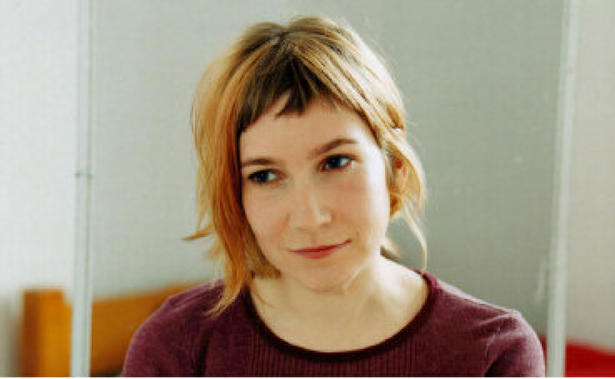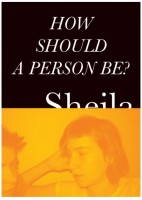Author Spotlight
I Wish I Sat Under Trees More: An Interview with Sheila Heti

Sheila Heti is the author of five books: the story collection, The Middle Stories (McSweeney’s Books); the novella, Ticknor (Farrar, Straus and Giroux); How Should a Person Be? (Henry Holt); and an illustrated book for children, We Need a Horse (McSweeney’s McMullins) featuring art by Clare Rojas. With Misha Glouberman, she wrote a book of “conversational philosophy” called The Chairs Are Where the People Go (Faber), which The New Yorker chose as one of its Best Books of 2011. She works as Interviews Editor at The Believer, and has contributed long interviews with writers and artists to the magazine.
Michael Kimball: I feel as if I should know why the collection is called The Middle Stories, but I don’t. Tell me?
Sheila Heti: I had been writing these short stories for a few years, in my early twenties, not thinking they would end up as a book, so the stories came first. Then the manuscript. Then I had to think of a title. I spent a lot of time on this, consulting a thesaurus and drawing little book covers in my notebooks. One day between classes (I was university at the time) the title just came to me: The Middle Stories. Pretty instantly I felt a kind of relief and pleasure. I liked the way it sounded. It made sense to me. It was one of those situations where you make your brain work really really hard on a puzzle, then the solution comes from some other-brained place. I recall trying it out in phrases, “Have you read The Middle Stories?” — imagining writers I knew saying it.
Kimball: So let’s talk about how your brain works on a story. I’m most interested in what I think of as the startling aspects in your stories, the things that jolt the reader in different ways. So just to take the first story in the collection, how did you come up with the idea to write a story about a princess and a plumber (and also include a frog in the story, but not let that frog be a prince)? And how did you decide to start the story with that great scene where the princess is tanning in the garden outside the castle and the plumber tries to talk to her. And how did you come up with a line like, “Still, what did a frog know about love?” And what about that scene on the bus where the little girl claims to be “in the middle of a very bad nightmare” (within another characters reality)? Feel free to pick and choose.
 Heti: Something funny about this story is that years later, I realised that the video game Super Mario Bros. is about a plumber trying to save a princess. I played that game a lot as a kid, so obviously somewhere in my subconscious was this thing about plumbers wanting to save princesses. But at the time of writing the story, I was not thinking about Super Mario. And you know my story which is a love story between a boy and a monkey? Just recently I was talking to a friend about that ridiculous tale we were taught in school in the ’80s about where AIDS came from (they said a man had sex with a monkey) and I wondered, “Is that where that story of mine came from?”
Heti: Something funny about this story is that years later, I realised that the video game Super Mario Bros. is about a plumber trying to save a princess. I played that game a lot as a kid, so obviously somewhere in my subconscious was this thing about plumbers wanting to save princesses. But at the time of writing the story, I was not thinking about Super Mario. And you know my story which is a love story between a boy and a monkey? Just recently I was talking to a friend about that ridiculous tale we were taught in school in the ’80s about where AIDS came from (they said a man had sex with a monkey) and I wondered, “Is that where that story of mine came from?”
So I don’t know how the brain makes stories, but it must have to do with deep memories or deep symbols. Certainly when I was writing The Middle Stories there was no conscious deliberation — it was just one sentence following rather quickly on the heels of the previous sentence. I was trying to write as quickly as possible at the time, like to make myself into a kind of writing machine, where I was at once very alert and very exact, trying to write these stories that would come out perfectly, and which I wouldn’t have to edit. So I was training myself to do what felt right in each moment. In some way, it felt like dancing. There’s brain-thought when you’re dancing, but mostly it’s in your body — your body decides your next move. In the case of writing, I think it’s as much in the fingers as in the head. Maybe the fingers get you deeper than the brain does.
Kimball: Yeah, Super Mario Bros, I didn’t even think of that. I wasn’t very good at that one, but maybe the video game is why the story resonates the way it does. And so the fingers: when things feel right on the keyboard, it reminds me of how the fingers can feel so right when playing a video game well. Is there anything in that?
Heti: I don’t know because I was never a good enough video game player! And it’s been so long… But I’ve noticed lately that sometimes an unedited paragraph, just glanced at on the screen, can look messy and wrong, while an edited one can look really smooth and good.
Kimball: One of the most striking things to me about your stories is the way that the matter-of-fact tone works with the modern fairy tales to make anything possible. Could you talk about the tone – how you found your way to it and how you use it to such startling effect?
Heti: I guess since I wasn’t trying to create any effect, the tone ended up matter-of-fact. I don’t know. When I was writing this book, I was just coming out of the world of theatre school, where I was writing plays. When you write plays, you know actors are going to be speaking the lines and adding a lot of the emotion. Perhaps in my head was still that idea that the emotion would be added later. This is just guessing on my part. I didn’t really anticipate anyone finding the stories surprising or matter-of-fact. As for the fairy tale element, I was reading Grimm and Aesop and Hans Christian Anderson at the time, and living at my father’s house, in his basement. My father told me stories every night when I was a child before I went to bed. He would make them up. So maybe some combination of being near my father and having read those stories turned my stories in that direction. But I wasn’t intending to write fairy tales or anything. I was thinking of them as “short stories,” that’s all.
Kimball: In an interview with Dave Hickey, you said, “Increasingly I’m less interested in writing about fictional people, because it seems so tiresome to make up a fake person and put them through the paces of a fake story. I just — I can’t do it.” Could you maybe talk more about the idea of the short story (and fiction) and how it’s changed or how you’ve changed in relation to it?
 Heti: When I said that, it was a few years into my work on How Should a Person Be? For a while by that point, writing fiction made no sense to me. It felt really meaningless. It was as if someone said, “Why don’t you do all these math problems” — setting before you a bunch of math problems — “and whatever numbers you come up with as answers with will be fine.” You would just be like, “Why should I bother doing these math problems?” There would be no fun or challenge in it. That’s how writing fiction felt to me: totally unconnected to anything real — both the process and the results.
Heti: When I said that, it was a few years into my work on How Should a Person Be? For a while by that point, writing fiction made no sense to me. It felt really meaningless. It was as if someone said, “Why don’t you do all these math problems” — setting before you a bunch of math problems — “and whatever numbers you come up with as answers with will be fine.” You would just be like, “Why should I bother doing these math problems?” There would be no fun or challenge in it. That’s how writing fiction felt to me: totally unconnected to anything real — both the process and the results.
I don’t know if fiction has changed, or if short stories have changed. But I’ve changed, I guess, in that I wanted to talk more directly to the world when I was writing How Should a Person Be? I didn’t care about that so much with The Middle Stories, so I had to find a way of bringing the world outside myself into my writing. Writing fiction all alone in a room – I just felt too isolated from the world. So I began taping conversations with my friends, and bringing that life into How Should a Person Be? and making up experiments with my friends, which I then wrote about in my novel as though those experiments were our real life. I tried to forge a stronger bond between the two.
Kimball: The stories in The Middle Stories are filled with the idea of the world changing and the characters can do nothing about it. “The Man with the Hat” is a story about change that cannot be controlled. In “The Princess and the Plumber,” the frog says, “The world is changing.” “The Woman Who Lived in Shoe,” the mailman says, “It’s a changing world.” “What Changed” is called, well, “What Changed.” Could you talk about why that idea shows up so explicitly in so many of the stories?
Heti: I never noticed that before. And no one has ever pointed it out until now. I suppose that was just how I felt at the time: that everything was changing. And yet at the same time, there’s a way in the stories in which nothing actually changes. People keep talking about change but everything is quite static, actually. Don’t you think? It’s not like the characters learn things and change. Or act differently as a result of what they’ve lived. That’s real change. I don’t think that ever happens in a story.
Kimball: Right, that’s true. The characters don’t change, but the world changes around them. Here’s a subject change: The opening paragraph of “My Favorite Monkey” made me want to go sit under a tree and see if anything romantic happened. Have you ever done that?
Heti: Probably not, but I think under a tree is a pretty romantic place to be. I wish I sat under trees more.
– – –
Michael Kimball is the author of Dear Everybody and, most recently, Us. His new novel, Big Ray, will publish September 18, 2012 (Bloomsbury).
Tags: michael kimball, middle stories, sheila heti

I enjoyed this, and added all of Sheila’s books to my list. Thank you, both of you.
nice. good to hear her admiting the mystery of why and how stories happen.
[…] Michael Kimball talks to Sheila Heti. There’s more talk of Super Mario Bros. than you might expect. […]
Great interview.